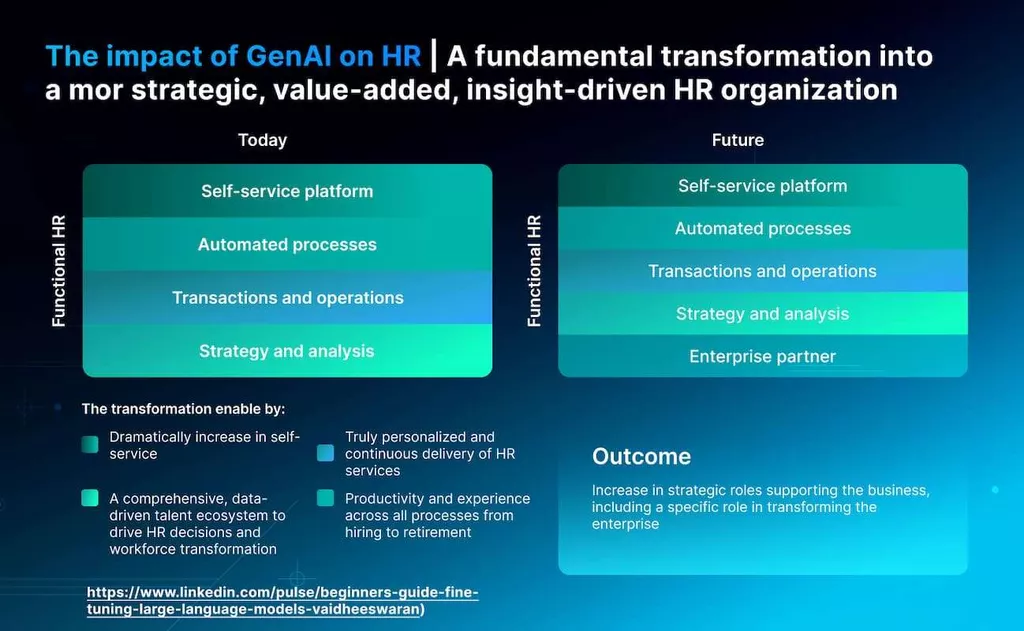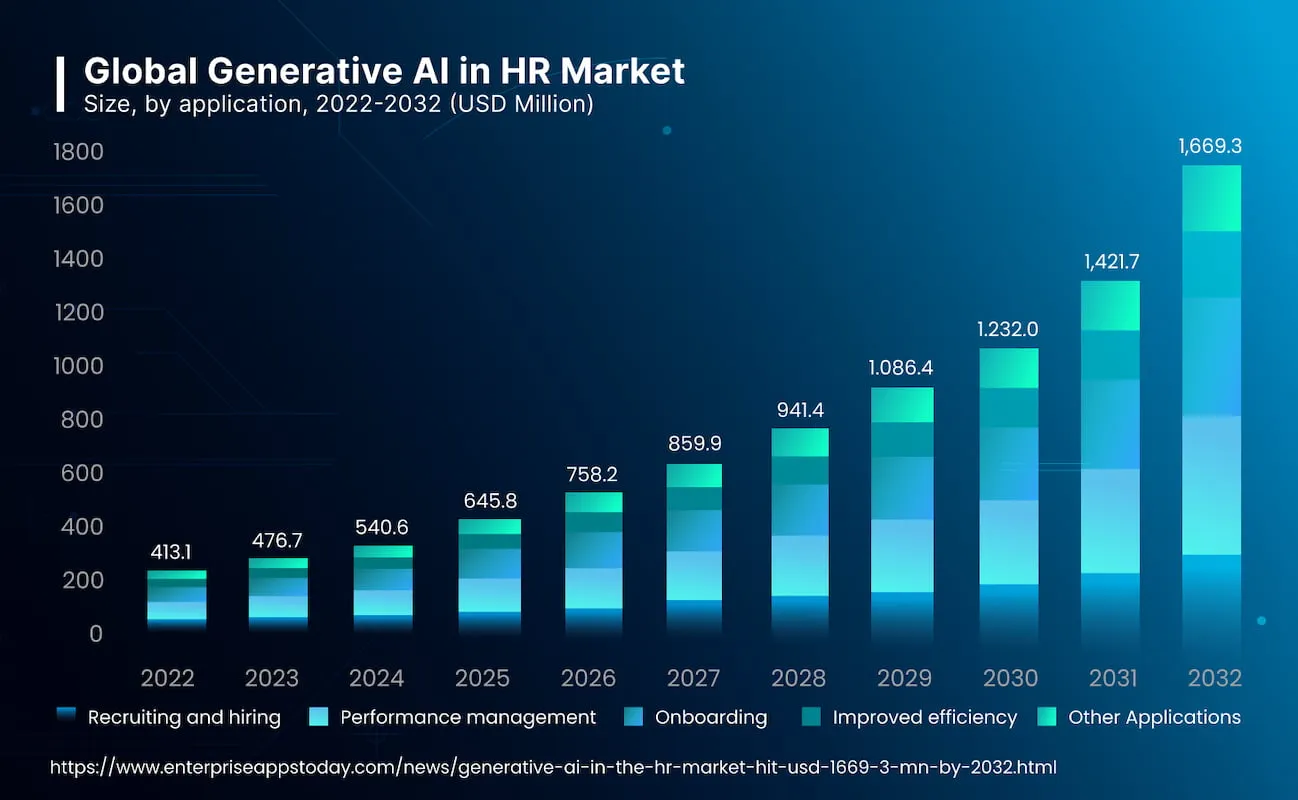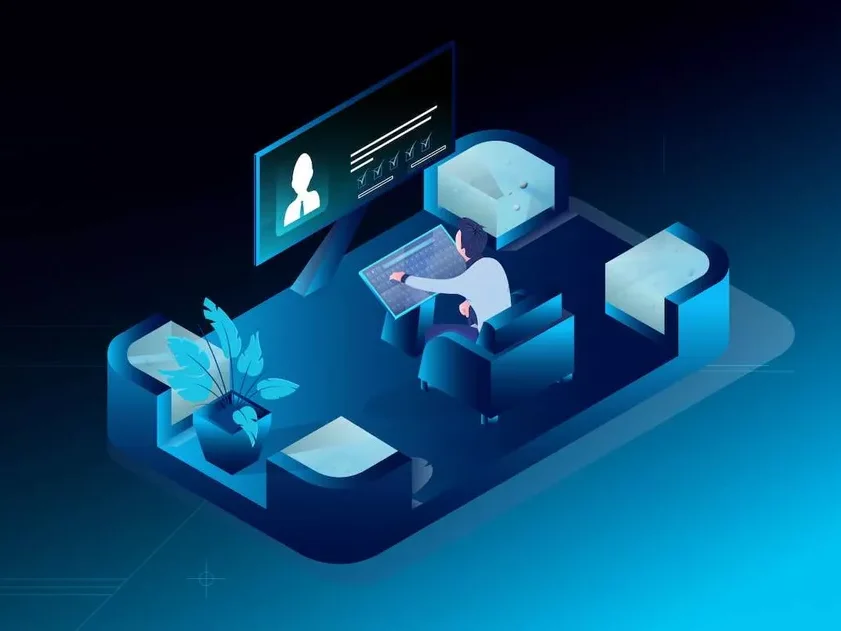Human resources (HR) are a critical component of any firm, making a massive contribution to specialists’ practice, their level of engagement, and the enterprise’s prosperity. But as the number of employees rises and the complexity of human dynamics changes, standard HR technologies cannot provide high efficiency, but they are being replaced by generative artificial intelligence (genAI) tools. Large language models for HR, e.g., GPT-4, have a great potential to interpret and compose content that is virtually indistinguishable from human content.
Such a technological breakthrough has already provided significant benefits when interacting with personnel. In this article, we will discuss the most promising LLM methods.
What Are LLMs, and How Do They Impact HR?
Large Language Models are enhanced generative models taught on large datasets that are designed to recognize and generate human text using the latest natural language processing (NLP) algorithms. LLMs have emerged as a critical part of the AI landscape with their ability to make a revolution in various business procedures, and HR is no exception. Let’s consider the main benefits of adopting such systems when interacting with personnel:
- Significant increase in self-service: previously, many employees reacted negatively to HR self-service. However, GenAI offers more conversational workflows and tailored data, so more professionals appreciate the ease of using LLM to meet their needs.
- Assistance in employee onboarding: language models simplify onboarding by creating personalized welcome messages, a comfortable training schedule, and providing the necessary resources. It makes an efficient and consistent onboarding process to collaborate with new professionals.
- Build a comprehensive talent pipeline: large language models for HR review job descriptions and applicants’ resumes to ensure a clear comprehension of skills and fit with the company culture. It allows HR reps to select candidates effectively, decreasing the hiring period and providing effective long-term employment.
With an LLM, HR representatives track professionals’ careers in real-time. Advanced HR tools allow you to get more insights about workers: what rhythm is convenient to work, what kind of training they need, during what period they may go on vacation, and whether they need to be reminded about the annual goals and development strategy of the company. HR representatives may also choose personalized onboarding programs and reward top performers.

How to Utilize LLM in HR?
GenAI has already helped 15% of HR departments, which have added it to their activities and optimized their performance monitoring procedures. Let’s look at a few of the most common ways in which the most forward-thinking HR departments use LLM:
Forming the ideal team
Today, HRs are using the potential of LLM for human resources to solve complex problems associated with personnel selection. Instead of labor-intensively sifting through anonymous information, recruiters are implementing genAI systems to identify patterns among top performers instantly. They no longer ask, «What qualities do we need in employees?» but, «What educational experiences will ensure our company’s long-term prosperity?». With this approach, you may create more targeted job advertisements and find the most talented applicants.
Automation of routine activities
HR representatives often have to perform different work in parallel, including administrative and routine work. Processing specialists’ documents, answering the most popular questions, and assisting with the adaptation and dismissal of workers – these kinds of activities, although key, take up a lot of working time.
Modern large language models assist in automating such activities, allowing HR experts to concentrate on more creative tasks. So, LLM chatbots inform potential employees about a firm’s corporate values or benefits. They also provide an easy and stress-free onboarding experience when interacting with new professionals.
Optimal interaction between employees
Any company strives to create a friendly atmosphere in the team. But improving communications, especially when it comes to large corporations, may be too difficult a task. LLM assists you in improving interaction between employees.
You can use sophisticated genAI systems to generate clear messages to prevent employee misunderstandings and improve communication. Such instruments are especially relevant in international companies because real-time translation of information allows you to forget about language barriers.
Analysis of remuneration systems
LLMs thrive on numbers. You should use AI-backed solutions to model existing salary levels and future growth opportunities and compare your performance with what other enterprises in the area offer. Defining trends and identifying deviations and differences in salary levels is important. It is an essential area of human resource management where a live agent must closely monitor the performance of the AI. The data that LLM provides is advisory, so the final say in remuneration matters will always belong to the HR director and managers.
Personnel training and development
Fortunately, the times when you had to flip through the pages of thick books to gain new knowledge are a thing of the past. In the modern world, specialists can ask model questions and instantly receive correct answers. This innovative approach not only improves adaptation but also changes the security procedure. Large language models for human resources analyze hypothetical scenarios and transform sophisticated steps into understandable recommendations that resemble human responses, improving the learning experience.
Informed decision making
It is impossible to imagine modern HR work without making informed decisions. However, in studying large datasets, difficulties may arise that LLM can successfully overcome.
Such structures look for patterns and obtain data from staff feedback, performance analysis, or engagement level research. This data can form the basis of an employee relations program, increasing employee satisfaction.
Limitations of Using LLM in HR
The Large language models are based on probabilistic neural networks, which means that with the same input dataset, they can show different results each time due to elements of randomness in the structure of the model or during the training process. Let’s consider other limitations of using large language models for HR area:
- Ethical biases: Despite the significant potential of LLMs, the ethical considerations associated with their use should not be neglected. The problems stem from the bias in the initial information used to develop the model. If the data contains bias or social bias, LLMs may reflect this in their results when dealing with job applicants or internal staff.
- Security and privacy issues: The massive volume of data stored by LLM may raise employee privacy and security concerns. Well-tuned LLMs can remember and recreate data they interacted with during training, which creates security risks. To solve this problem, you must strictly adhere to anonymization, encryption, and access control rules to protect confidential information.
The active development of generative AI for HR promises to overcome these difficulties. We can rely on advanced natural language interpretation and predictive analytics to help us anticipate the needs and challenges that staff may face. Improving LLM will optimize interactions with staff and take their experience to the next level.
Tips and Reminders to Implement LLM в HR
LLMs effectively analyze information across the entire firm in real-time. Therefore, you can create one solution suitable for HR and other company activities. Moreover, each department may adapt the system according to its needs. We have collected key recommendations to implement LLM in the HR area:
- Determine best use cases: Estimate business operations to identify HR sectors where LLM can provide the most benefit, e.g., job selection, staff training, etc.
- Select the optimal model: Choose the appropriate solution based on business needs, task complexity, system capacity, and resource requirements.
- Collect and tune dataset: Collect and process information to fine-tune your model to fit your business context and deliver optimal results.
- Performance monitoring and analysis: Regularly analyze LLM performance using parameters such as precision, response time, and user accessibility to define sectors you may improve.

MarketResearch calculates that the generative AI industry will achieve $1,669.3 billion by 2032, with the most growth in recruiting and hiring tasks. It is vital to begin adopting the system today to remain competitive.
Final Words
Implementing AI for HR goes beyond optimizing standard procedures. Advanced genAI offers diverse tools, from finding talent to creating comfortable conditions for staff. They enable HR reps to make informed decisions, ensure and
MetaDialog offers you personal LLM and AI-backed conversation solutions based on your database. You may book a demo to evaluate whether our digital products suit your situation. As we implement our LLRs, the role of HR changes: it becomes not just a team but a strategic partner in creating the firm’s future.
